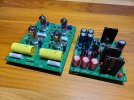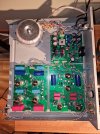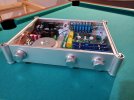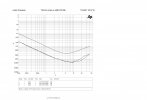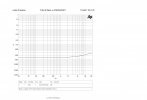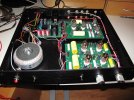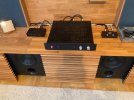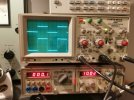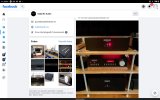DanielT
Major Contributor
Or have had, listened to a Williamson tube amplifier? Impression?
Are they available?
What can one, in reasonable condition, cost?
I could really imagine having one. Mostly for its HiFi history. Not as a main amp but in some nice secondary system. Then together with a subwoofer + LP/HP filter sub-speaker. Speakers that the Williamson tube amplifier would like to drive.
Not as a main amp but in some nice secondary system. Then together with a subwoofer + LP/HP filter sub-speaker. Speakers that the Williamson tube amplifier would like to drive.
I might add that when I say have such an old amplifier as a general tip, you should be knowledgeable about electronics or, as in my case, have a friend who is knowledgeable (I help him with other things). Taking amplifiers to professional repairman, who charge by the hour, can be expensive.
Do you think the technical data in the Wikipedia link below is correct?:
15 W, 0.1% distortion, straight FR?
Good damping (factor) is mentioned. What kind of damping factor it is and what it is compared to, one might wonder.
The Williamson amplifier is a four-stage, push-pull, Class A triode-output valve audio power amplifier designed by D. T. N. Williamson during World War II. The original circuit, published in 1947 and addressed to the worldwide do it yourself community, set the standard of high fidelity sound reproduction and served as a benchmark or reference amplifier design throughout the 1950s. The original circuit was copied by hundreds of thousands amateurs worldwide.[1] It was an absolute favourite on the DIY scene of the 1950s, and in the beginning of the decade also dominated British and North American markets for factory-assembled amplifiers.
The Williamson circuit was based on the 1934 Wireless World Quality Amplifier by Walter Cocking, with an additional error amplifier stage and a global negative feedback loop. Deep feedback, triode-connected KT66 power tetrodes, conservative choice of standing currents, and the use of wide-bandwidth output transformer all contributed to the performance of the Williamson. It had a modest output power rating of 15 Watts[a] but surpassed all contemporary designs in having very low harmonic distortion and intermodulation, flat frequency response throughout the audible frequency range, and effective damping of loudspeaker resonances. The 0.1% distortion figure of the Williamson amplifier became the criterion for high fidelity performance[2][3] that remains valid in the 21st century.[4]
Or maybe one should let such an old amplifier remain in some radio museum for display only, considering this:
The Williamson amplifier was sensitive to selection and matching of passive components and valves, and prone to unwanted oscillations at infrasonic and ultrasonic frequencies. Enclosing four valve stages and an output transformer in a negative feedback loop was a severe test of design, resulting in a very narrow phase margin or, quite often, no margin at all. Attempts to improve stability of the Williamson could not fix this fundamental flaw. For this reason, and due to high costs of required quality components, manufacturers soon abandoned the Williamson circuit in favour of inherently more stable, cheaper and efficient three-stage, ultralinear or pentode-output designs.
 en.wikipedia.org
en.wikipedia.org
Here is a video for the technically interested:
Edit:
I don't even really know what it looks like. There are pictures online but I think it mostly looks like variations on that amp. Can anyone produce a picture of the original? It would be nice to see what it looks like.
Are they available?
What can one, in reasonable condition, cost?
I could really imagine having one. Mostly for its HiFi history.
I might add that when I say have such an old amplifier as a general tip, you should be knowledgeable about electronics or, as in my case, have a friend who is knowledgeable (I help him with other things). Taking amplifiers to professional repairman, who charge by the hour, can be expensive.
Do you think the technical data in the Wikipedia link below is correct?:
15 W, 0.1% distortion, straight FR?
Good damping (factor) is mentioned. What kind of damping factor it is and what it is compared to, one might wonder.
The Williamson amplifier is a four-stage, push-pull, Class A triode-output valve audio power amplifier designed by D. T. N. Williamson during World War II. The original circuit, published in 1947 and addressed to the worldwide do it yourself community, set the standard of high fidelity sound reproduction and served as a benchmark or reference amplifier design throughout the 1950s. The original circuit was copied by hundreds of thousands amateurs worldwide.[1] It was an absolute favourite on the DIY scene of the 1950s, and in the beginning of the decade also dominated British and North American markets for factory-assembled amplifiers.
The Williamson circuit was based on the 1934 Wireless World Quality Amplifier by Walter Cocking, with an additional error amplifier stage and a global negative feedback loop. Deep feedback, triode-connected KT66 power tetrodes, conservative choice of standing currents, and the use of wide-bandwidth output transformer all contributed to the performance of the Williamson. It had a modest output power rating of 15 Watts[a] but surpassed all contemporary designs in having very low harmonic distortion and intermodulation, flat frequency response throughout the audible frequency range, and effective damping of loudspeaker resonances. The 0.1% distortion figure of the Williamson amplifier became the criterion for high fidelity performance[2][3] that remains valid in the 21st century.[4]
Or maybe one should let such an old amplifier remain in some radio museum for display only, considering this:
The Williamson amplifier was sensitive to selection and matching of passive components and valves, and prone to unwanted oscillations at infrasonic and ultrasonic frequencies. Enclosing four valve stages and an output transformer in a negative feedback loop was a severe test of design, resulting in a very narrow phase margin or, quite often, no margin at all. Attempts to improve stability of the Williamson could not fix this fundamental flaw. For this reason, and due to high costs of required quality components, manufacturers soon abandoned the Williamson circuit in favour of inherently more stable, cheaper and efficient three-stage, ultralinear or pentode-output designs.
Williamson amplifier - Wikipedia
Here is a video for the technically interested:
Edit:
I don't even really know what it looks like. There are pictures online but I think it mostly looks like variations on that amp. Can anyone produce a picture of the original? It would be nice to see what it looks like.
Last edited:




